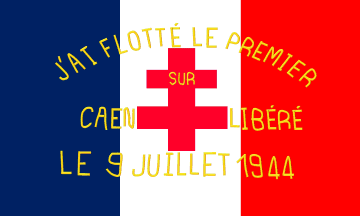The Flag of Free France (1940-1944). Image Courtesy of Wikimedia Commons
The French Resistance plays a pivotal role in the remembrance of Free France during WWII for France. The French Resistance comprised several organizations that merged for one goal—the liberation of France. The French Resistance officially operated from the summer of 1940 to the slow dissolution in 1944 after the Liberation of Paris. The French Resistance worked within the split occupation, Free France and the Vichy regime, and fed information to the Allies. While many believe the resistance was a group of clandestine cells that operated independently, the resistance was a vast and well-organized record with intentionality behind every move.
When coming to France, I had expected there to be instances where the flag of the French Resistance was raised alongside the French flag—particularly on government buildings around the annual holiday of VE day. However, I only saw the flag of Free France in museums dedicated to the remembrance of the liberation movement of France. I was taken aback at first since the flag of Free France has a deep connection to the history of France.
The Flag of Free France symbolizes the movement’s mission—the liberation of France. The basis of the blue, white, and red is congruent to the flag of France since the French Revolution; the three colors represent liberty, equality, and fraternity. The flag also encompasses the Cross of Lorraine in the middle portion. The cross is also symbolic of France; the cross was used by the French in previous centuries when Germany annexed the provinces of Lorraine in eastern France. There is a close tie between using the French flag and resistance to German aims. So, why not continue to use this flag that helped reclaim France? Upon reflection, the goal of Free France was not to create a new country or governmental system but to instill the liberation of France from the annexation of the Vichy regime. France fought to unify France rather than further divide it. The tri-colored French flag was reinstituted after WWII because Free France fought for liberty, equality, and fraternity, similar to what their revolutionary ancestors fought for in the French liberation in the French Revolution.




